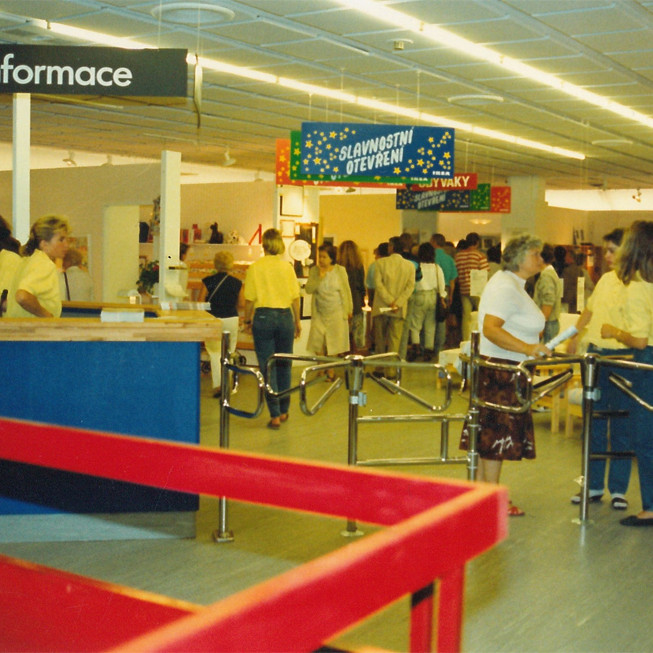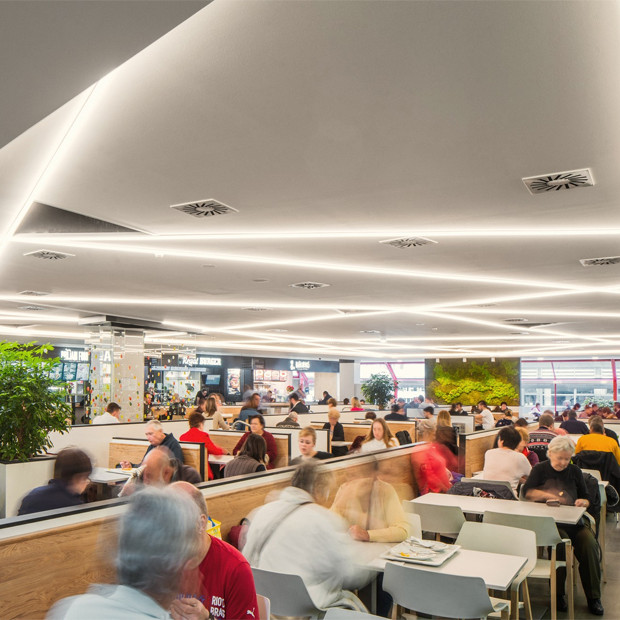
Why was DBK created?
The house of residential culture was to become a showcase of the Czechoslovak furniture industry. The operator and investor of the construction was the branch company Nábytek, which covered the sale of furniture in its own retail network throughout the territory of the Republic. The house of residential culture was created primarily from the need to present the full breadth and diversity of Czechoslovak furniture production, and was also intended to replace the small insufficient stores in Prague and to centralize the offer.

1972–1981 Construction
The first designs by the architect Věra Machoninová (more about her work here) are from 1968-1969, the construction itself began in 1972 (that is, simultaneously with the construction of the Budějovická metro station), the department store was not opened to customers until 1981. This delay was caused not only by shortcomings in socialist construction, but mainly by the fact that the project was financed by a state enterprise, not the Ministry of Internal Trade itself, as was the case with Kotva or Máj.

1981 opening of the DBK building
The building of the House of Residential Culture was conceived very generously, in addition to furniture exhibitions, sales counters and warehouses, there was also a specialized department of residential architects, a snack bar, a restaurant, a modern large-capacity car park, a monumental escalator hall with a wavy ceiling, a cinema hall and changing rooms. with storage room. The interior was made up of three basic colors – red, which dominated the areas for customers, green, which distinguished the service areas and offices, and a distinctive dark blue, which decorated the cinema hall and some navigation panels. The house of housing culture was the first large Prague department store that was built only with the help of domestic contractors, so unusual solutions had to be sought often - one of them is, for example, the "Atmofix" facade sheet, which dominates the building to this day.

80. years
In the 1980s, the housing culture house really became a center for everyone who wanted to furnish their home. Above all, the new residents of the new block of flats, which sprung up not only in Prague like mushrooms after the rain in the 70s and 80s, went to DBK for inspiration, but especially for shopping. DBK offered the sale of sectional furniture, kitchens, bedrooms, so-called living room walls, upholstered furniture, home accessories and textiles, lighting, carpets, wallpapers and much more. In a very modern way (for its time it was a very innovative undertaking), the department store provided customers with modular or sectoral furniture solutions tailored to the individualized designs of residential architects and interior designers. DBK tried to offer the maximum of what the centrally controlled economy and limited exports allowed, but compared to today, the supply was limited and far from satisfying the demand. Although suppliers (for example, Dřevotvar, Jitona, HIKOR, Ton, UP, Interiér Praha and many others) supplied DBK with priority, it was very often difficult for customers to even get on the waiting list for a new kitchen or bedroom.

90. years and IKEA
After 1989, o. p. Nábyt ceased to be a monopoly player on the furniture retail market. In September 1991, the world's largest furniture chain IKEA moved into DBK, which transformed the House of Living Culture into its very first showroom and store in Czechoslovakia, respectively the Czech Republic. IKEA lasted 5 years in DBK - after building its own site in Zličín, it moved out of DBK. Later, the building was operated as a department store in the PRIOR network. The 7th floor was also completed in the 1990s.

2000 / New Millennium and Reconstruction
In 2006, DBK underwent a reconstruction, which primarily focused on the accessibility of the building, technical distribution and modernization of sales areas. The aim was to start operating the building as a shopping center with an extensive range of shops and services, including several restaurants and a large supermarket. In 2006, the new shopping center also returned to the time-honored name it still uses today – DBK. After 2000, the area around DBK was gradually built up with several other buildings, which changed the face and character of Budějovice Square.
